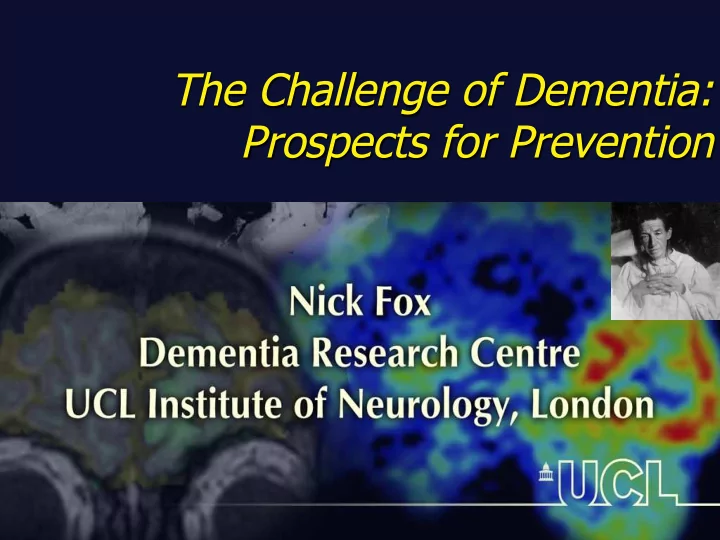

The Challenge of Dementia: Prospects for Prevention
A 100 year journey from discovery to prevention trials?
Alzheimer and Auguste D
Amyloid Plaque Brain atrophy Neurofibrillary Tangle
Dementia is not the same as Alzheimer’s disease
Dementia and Alzheimer’s disease • Dementia: impairment of cognitive functions – Usually progressive – Sufficient to interfere with daily life • Alzheimer’s disease is the most common cause but many others – including treatable and preventable causes
Causes of Dementia • Neurodegenerative – Alzheimer ’ s Disease (AD) – Parkinson’s Dementia & Dementia with Lewy Bodies (DLB) – Frontotemporal lobar degeneration (FTLD) – Huntington ’ s disease • Vascular (VaD) • Other causes – Brain tumours, infections (HIV, syphilis), vitamin and hormone deficiencies, Creutzfeldt Jakob disease (CJD),
Causes of dementia Vascular dementia 15% Alzheimer ’ s disease Dementia with 50-60% Lewy bodies 15% Frontotemporal Dementia 5% HIV, Head injury, Prion diseases/CJD, Corticobasal degeneration, Other PSP, Huntington ’ s, alcohol-related dementia, tumours, infections, vitamin & hormone deficiencies, … ~2%
Dementia Research Group
Dementia: a demographic time bomb with aging populations Age (Years) Prevalence 40-65 0.1% (1 in 1,000) 65-70 2.0% (1 in 50) 70-80 4.0% (1 in 25) 80 Plus 20.0% (1 in 5) Prevalence doubles with every 5 years of age over 65 Source: Alzheimer's Society
Those born in 2013 can expect to live to over 90y Office of National Statistics & Christensen et al (2009) Lancet
Dementia is common and getting more common • 800,000 people with dementia in UK • 160,000 new cases per year - one every ~3 minutes • ~40% of the population have a family member or close friend with dementia Matthews F et al. (2005) The Incidence of Dementia PLoS Medicine, 2, e193 Alzheimer ’ s Research Trust / YouGov, 2008
Dementia 4% of 70-74y 8% of 75-79y 16% of 80-84y olds 2014 • £23 billion cost to UK • ¼ of hospital beds • ¾ of those in residential care • ½ of us will care for someone …
Risk Factors – those we cannot do much about • Age • Family history (RR ~ 2) • Genetic risk – Rare familial cases – Genetic risk modifiers • Female > male “Choose your parents carefully and die young” - Selkoe
AD: Genetics and Risk • Risk related to family history depends on detail: numbers affected, age at onset … • APOE – is the major genetic risk factor – ~1/5 of the population have an E4 allele – ~2/3 of AD patients have an E4 allele • Familial AD accounts for only 1% but has given great insights into the disease – Three different genes – each is rare – Onset may be as early as 30 yrs
Risks we can do something about? • Smoking • Diabetes • Raised blood pressure • Raised cholesterol • Head injury • Exercise • Depression • Education – use it or lose it?
Prevalence is increasing but is there evidence that it is not increasing as fast as expected in developed economies? Changes in UK age-specific prevalence 1990-2010
A range of proposed interventions… Can walking keep your mind young?
But when do we need to act to prevent, delay or reduce the risk of diseases that cause dementia: e.g. Alzheimer’s disease and vascular dementia?
When do we need to treat ? • When does the disease start to cause irreversible losses? • When most to save? • When we (individuals or society) would want disease modification? • Failure of trials to date in AD? Too little … too late?
Brain imaging – MRI – allows us to “see” the brain in life Healthy control Alzheimer’s
Benefits of earlier intervention Fewer neurons lost = more to save I n moderate AD some parts of the brain have already lost 1/3 of their volume
H Time 0 18months 36months Serial MRI of an individual with initially mild AD
Scan 1
Scan 2 – 1 year later
In “ mild ” AD the hippocampus is on average already ~20% smaller than controls Seab ’88, De Leon ’89, Scheltens ’92, Soininen ’94, Jack ’99, Du ’01, Killiany ’02
How and when does Alzheimer’s disease begin? • Recognition of a preclinical period to AD • Isolated memory or other deficits – 5-10% progression to AD per year • Could we see changes with imaging? • Would that offer an opportunity for treatments to prevent symptoms? • How could we study people before symptoms?
Rarely Alzheimer’s is inherited - usually young onset ? Allows us to study “ at-risk ” subjects
94 95 93 4/97 96 11/97 AD: At risk subject - serial scans registered to 1993 baseline
93 11/97 Red = loss
Brain Volume as percentage of TIV 90 85 Normal range: 95%CI 80 Symptoms 75 70 65 2500 0 500 1000 1500 2000 Time since first scan (days)
Could we image amyloid plaques? [ 11 C] PIB, Flutemetamol, Florbetapir, Florbetaben
And now – tau – the tangles that Alzheimer saw
Amyloid increases some years before AD symptoms – perhaps more than 10y before Remains well Subsequently converted to AD Brooks, Archer, Okello
So if we can detect and track presymptomatic changes … • Could we trial treatments at this stage? • What would their chances of success be? A window of opportunity to delay onset of Alzheimer’s disease
100 years on from Alzheimer and Auguste D • We can now see what Alzheimer could not – changes in the brain in life • We know there is a long pre-clinical period – perhaps 10-15 years • We can see and track changes before symptoms And finally we are starting trials to slow or delay the onset of disease
• I would like to acknowledge the tremendous and selfless contributions of patients and at risk subjects and their families in taking part in research And thank you for listening
Recommend
More recommend